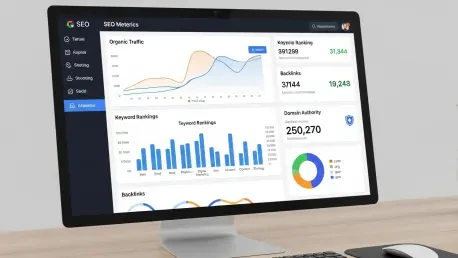Overview of a Shifting SEO Landscape
In the dynamic world of search engine optimization, a seismic shift has rattled the industry with the unexpected removal of a critical tool in Google Search Console, sending shockwaves through the community of SEO professionals, website owners, and digital marketers. This change, affecting how data is accessed and analyzed, has sparked debates about data accuracy and raised questions about the future of performance tracking in an industry already navigating rapid technological advancements and evolving user behaviors. With major players like Google setting the pace for innovation and policy, smaller entities and independent professionals often find themselves adapting to abrupt changes with little forewarning. The current scenario underscores a broader tension between maintaining robust data insights and coping with unilateral updates from dominant search engines.
The focus of this industry report is to dissect the implications of this specific alteration in Google’s framework, exploring its immediate effects on performance metrics, the challenges it poses to the SEO community, and the potential long-term outcomes for data reporting. Through detailed analysis and expert insights, this discussion aims to provide clarity on a complex issue that continues to reshape digital strategies across the board.
Understanding the Num=100 Parameter and Its Role in SEO
The num=100 parameter in Google Search Console was a pivotal feature that enabled users to view up to 100 search results per page, offering a broader snapshot of how websites performed across various queries. This functionality was instrumental for SEO specialists who needed comprehensive data to analyze trends, identify opportunities, and address weaknesses in search visibility. By expanding the scope of visible results, it provided a deeper understanding of a site’s reach within Google’s ecosystem.
Historically, this parameter played a significant role in shaping performance metrics by allowing for more granular tracking of impressions, clicks, and keyword rankings. Its presence meant that analysts could capture a wider array of data points in a single view, facilitating more informed decision-making. Over time, it became a cornerstone for benchmarking website success and comparing competitive landscapes, embedding itself into the workflows of many in the field.
Key stakeholders, including Google as the primary search engine, SEO professionals who interpret and act on data, and platforms like Semrush and Accuranker that aggregate and report metrics, have all relied heavily on such tools for accuracy. The interconnected nature of these entities highlights how integral the num=100 parameter was to maintaining a cohesive data ecosystem. Its removal, therefore, disrupts not just individual strategies but the broader machinery of SEO analytics.
The Immediate Impact of Num=100 Removal on SEO Metrics
Key Data Insights and Website Performance Declines
Analysis conducted on 319 properties by a leading technical SEO expert revealed staggering declines in critical metrics following the removal of the num=100 parameter. An alarming 87.7% of these sites reported a drop in impressions, a key indicator of visibility on search engine result pages. Simultaneously, 77.6% experienced a reduction in unique ranking keywords, signaling a substantial loss in the diversity of terms driving traffic.
Particularly hard-hit were short-tail and mid-tail keywords, which often form the backbone of organic search strategies for many websites. These keyword categories saw the most pronounced losses in visibility, as the parameter’s absence curtailed the ability to track performance across a wide range of search results. This shift has left many site owners grappling with diminished insights into how their content resonates with broader audiences.
Moreover, there has been a notable change in rank positions, with a higher concentration of queries appearing in the top 3 spots or on the first page, while fewer are found on page 3 or beyond. This redistribution suggests that the removal may have stripped away inflated or less relevant data, potentially offering a clearer view of true ranking strength. However, for many, this comes at the cost of reduced overall visibility in performance reports.
Broader Trends in Data Reporting and Industry Response
Across the industry, performance reports now paint a bleaker picture, even in cases where actual rankings may not have shifted. The apparent downturn in metrics like impressions and keyword counts has led to widespread concern among website managers who depend on these figures to demonstrate value and secure budgets. This discrepancy between reported data and real-world outcomes has fueled frustration and confusion.
Experts, including notable industry voices like Brodie Clark, have posited that prior data may have been artificially boosted by rank trackers and scrapers exploiting the num=100 parameter. If true, this theory indicates that the current metrics, though lower, might reflect a more accurate depiction of performance. Such a perspective challenges the community to reconsider how success is measured and reported in the wake of this change.
SEO platforms such as Semrush and Accuranker have not been immune to the fallout, publicly acknowledging disruptions in their data collection and reporting capabilities. These tools, integral to many professionals’ daily operations, are now in the process of recalibrating their systems to align with the new reality. Their ongoing efforts to adapt underscore the widespread ripple effects of Google’s decision on the entire SEO toolkit ecosystem.
Challenges Facing the SEO Community Post-Removal
The SEO industry finds itself in a state of uncertainty due to Google’s ambiguous stance on whether the num=100 removal is a permanent fixture or a temporary adjustment. Without definitive guidance, professionals are left to speculate on the longevity of current challenges, impacting their ability to plan effectively for future campaigns. This lack of certainty exacerbates the difficulty of navigating an already complex field.
Immediate hurdles include a marked reduction in visibility within performance metrics, which hinders the ability to assess true online impact. Analytics tools, once reliable for delivering comprehensive insights, are now struggling to provide consistent data, leaving gaps in understanding. Additionally, interpreting this altered data landscape poses a steep learning curve for those accustomed to previous reporting standards.
To counter these obstacles, SEO practitioners are encouraged to pivot toward alternative metrics, such as click-through rates or user engagement statistics, which may offer complementary insights. Refining data collection methods by leveraging other Google tools or third-party solutions could also mitigate some losses. These adaptive strategies, while not fully replacing the lost functionality, provide a pathway to maintain some level of analytical depth during this transition.
The Regulatory and Communication Gap from Google
A significant point of contention within the industry is the absence of official communication from Google regarding the num=100 parameter’s removal. This silence has left SEO professionals without a clear understanding of the rationale behind the decision or its expected duration. Such a gap in dialogue fosters mistrust and complicates efforts to align with evolving search engine policies.
Google’s unilateral changes often have far-reaching consequences on industry practices, as seen in this instance where data reporting frameworks have been upended. The lack of transparency not only disrupts operational workflows but also undermines confidence in the search engine’s commitment to supporting its user base. This dynamic highlights a critical need for more open channels of communication to ensure collaborative progress.
Compliance with shifting policies remains a persistent challenge for websites aiming to maintain optimal visibility and performance. Strategic planning becomes a guessing game when updates are rolled out without context or forewarning, forcing rapid adjustments that may not always align with long-term goals. Addressing this communication shortfall is essential for fostering a more stable environment where data-driven decisions can thrive.
Future Implications for SEO Metrics and Data Accuracy
Looking ahead, the removal of the num=100 parameter could herald a new era of cleaner, more accurate ranking data, free from the distortions potentially caused by automated tools and scrapers. If sustained, this shift might encourage a recalibration of how success is defined, focusing on genuine user interactions rather than inflated metrics. Such an outcome could ultimately strengthen the integrity of SEO analytics.
Emerging opportunities abound for SEO professionals willing to refine their strategies in light of truer performance indicators. This may involve a deeper emphasis on content quality, user intent, and other qualitative factors that influence rankings beyond raw numbers. Adapting to this paradigm offers a chance to build more resilient approaches that withstand future disruptions in data access.
External factors, including innovations in SEO tools from platforms like Semrush, Google’s ongoing updates to its algorithms, and changing consumer search behaviors, will also shape the trajectory of the industry. Staying attuned to these developments will be crucial for maintaining a competitive edge. As the landscape evolves from this year into 2026 and 2027, agility and foresight will define those who lead in this space.
Reflecting on a Transformative Shift
Looking back, the removal of the num=100 parameter stood as a defining moment for the SEO industry, revealing both vulnerabilities and opportunities within data reporting systems. The significant declines in impressions and keyword visibility initially painted a grim picture, yet the potential for more accurate rankings offered a silver lining. This duality captured the essence of a community caught between immediate setbacks and the promise of long-term improvement.
As a path forward, SEO professionals were urged to explore diverse data sources beyond traditional Google Search Console metrics, integrating insights from user behavior analytics and other platforms to build a fuller picture of performance. Advocating for enhanced transparency from Google emerged as a key priority, ensuring that future changes were accompanied by clear explanations and timelines. These steps aimed to restore confidence and equip the industry to handle similar transitions with greater preparedness.
Moreover, investing in education and tool development was seen as vital to navigating this altered terrain. By fostering innovation in how data is collected and interpreted, the community could turn challenges into catalysts for growth. This forward-thinking approach promised to not only address the fallout from the parameter’s removal but also position SEO strategies for sustained success in an ever-changing digital environment.









